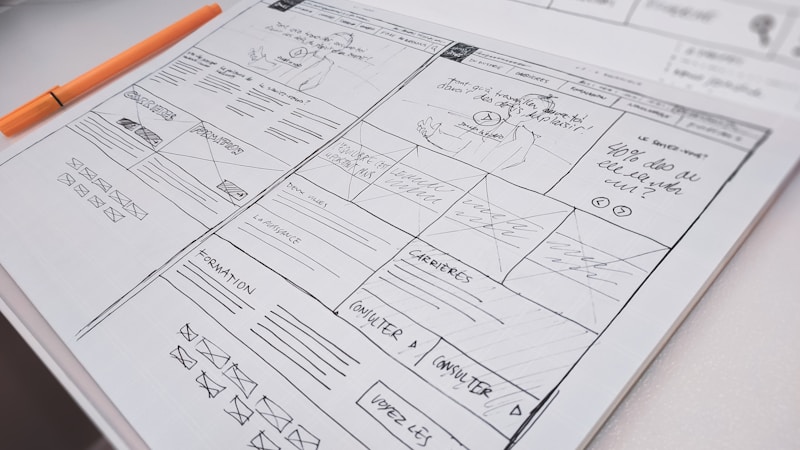Creating the Ideal User Persona: Essential Steps for Targeted Strategies
Are you struggling to identify your target audience and tailor your marketing and product development efforts to their unique needs?
Imagine being able to create a vivid picture of your ideal customers, understand their motivations, and design products that resonate with them. User personas can help you achieve this and more.

Below, we’ll explore the essential steps to crafting a user persona library that drives targeted strategies and results in business success. We hope you'll appreciate the information, and that you'll consider trying Userforge to help your team create effective personas, together!
Key Takeaways
User personas provide a foundation for success by aligning business goals with customer needs through user research and market insights.
Gathering data is essential to create accurate user personas that represent the target audience’s needs and preferences.
User personas can be used to drive targeted strategies, guide product design, and align organizational goals with customer needs.
Understanding User Personas: The Foundation for Success
User personas serve as the guiding force for your marketing and product development endeavors. They are semi-fictional representations of your ideal customers based on real data and insights gathered through user research.
Creating and implementing user personas helps align your marketing decisions to be more informed, targeted, and efficient.
Understanding user personas starts with user research. Carrying out customer interviews, deploying surveys, and scrutinizing existing data sources helps establish a comprehensive understanding of your target audience and their requirements.
By incorporating market research, these personas can then be used to direct your marketing efforts, guide product design, and align your organizational goals with the needs of your target customers.
Constructing user personas helps maintain alignment between your business and the dynamic needs and preferences of your target audience. To build user personas, start by listing their key characteristics and preferences. Building user personas is an essential step in understanding your customers better.
What are user personas?
User personas are semi-fictional portrayals of your ideal customers, designed to yield insightful information about their motivations, goals, and challenges.

They are typically based on real data and insights gathered through user research, such as customer interviews, surveys, and existing data sources.
Personas serve as a reference point for your marketing and product development teams, ensuring that everyone is on the same page when it comes to understanding the most important user groups.
Creating user personas involves:
Identifying patterns and trends among your target users
Organizing them into persona groups
Giving each group a fictional name, a set of personality traits, and a list of goals and pain points based on real users
Finally, to create personas, create a persona for each group to better understand and address their needs
This approach gives a clear image of your ideal customer, enabling you to customize your marketing initiatives and product design to meet their precise needs.
Why user personas matter
User personas matter because they help businesses make data-driven decisions, adapt their marketing efforts to specific customer segments, and develop products that address users’ unique needs and pain points.

By understanding the motivations, goals, and frustrations of your target audience, you can create more impactful marketing campaigns, improve customer satisfaction, and ultimately drive business growth.
For example, a travel app company might use user personas to identify the key features and functionalities that their users value the most, such as personalized recommendations or seamless booking experiences.
By focusing on these aspects, the company can align their product development and marketing strategies with the needs of their target users, resulting in a more successful and user-centric product.
Gathering Data: The Building Blocks of User Personas
Accurate and effective user personas necessitate the collection of appropriate data. This involves conducting user research through customer interviews, surveys, and questionnaires, as well as analyzing existing data sources like website analytics and customer support tickets.
Collecting a broad spectrum of data allows your user personas to be rooted in real-life insights and accurately mirror the needs and preferences of your target audience.

Once you’ve gathered all the data, it’s time to organize and segment it. This involves identifying patterns and trends among users, grouping them into customer segments, and using this information to create detailed persona profiles. This ensures that your user personas are rooted in actual data and genuinely represent your target audience.
Customer interviews
Customer interviews are an essential tool for gathering valuable insights into users’ motivations, goals, and pain points.
Conducting comprehensive user interviews, with your target audience offers insights into their experiences, preferences, and challenges. This knowledge enables the creation of user personas that truly resonate with them.
To conduct effective customer interviews, it’s crucial to ask open-ended questions that encourage users to share their thoughts and feelings.
Additionally, it’s important to create a comfortable and non-judgmental environment, ensuring that users feel at ease when discussing their experiences. This approach enables the collection of rich and meticulous data that will be instrumental in forming your user personas.
Surveys and questionnaires
Surveys and questionnaires are another valuable method for collecting data from a larger audience. Disseminating surveys and questionnaires among your target users allows the collection of quantitative data about their preferences, needs, and behavior. This data helps identify trends and patterns that contribute to the creation of your user personas.
To get the most out of your surveys and questionnaires, it’s essential to ask clear and concise questions that focus on users’ goals, frustrations, and motivations.
It's also crucial to ensure that your surveys are distributed to a representative sample of your target audience, ensuring that the data you collect is truly reflective of your users’ needs and preferences.
Analyzing existing data sources

Existing data sources, such as website analytics and customer support tickets, can be a goldmine of information when it comes to understanding user behavior. By analyzing this data, you can gain valuable insights into how users interact with your product or service, what features they value most, and what challenges they face.
For example, analyzing website analytics data can reveal valuable insight into which pages are most popular, how users navigate through your site, and where they encounter difficulties.
Similarly, examining customer support tickets can provide insights into common issues and pain points that users face, allowing you to address these problems in your product design and marketing efforts.
Utilizing existing data sources ensures that your user personas are rooted in actual user behavior and experiences.
Crafting User Personas: Bringing Your Users to Life
Now that you’ve gathered and organized your data, it’s time to craft your user personas. This involves creating detailed profiles that include:
Demographics
Goals
Frustrations
Motivations
Prioritize personas based on their relevance to your business objectives. This ensures that your user personas are an accurate representation of your target audience, providing a solid user base, for your marketing and product development initiatives.

When crafting user personas, it’s essential to create profiles that are based on real data and insights. This ensures that your personas are truly representative of your target audience and can be used to inform your marketing efforts, guide product design, and align your organizational goals with the needs of your customers.
Organizing and segmenting data
Organizing and segmenting data is a crucial step in the process of crafting user personas. By identifying patterns and trends among users, you can group them into persona groups based on their shared characteristics, behaviors, and preferences.
This segmentation allows you to create targeted marketing campaigns and develop products that cater to the specific needs of each user persona group.
To effectively organize and segment data, you should look for similarities between users, such as demographics, goals, and pain points. Identifying these patterns enables the construction of detailed user personas that accurately represent the needs and preferences of your target audience.
Additionally, segmenting data can help you prioritize personas based on their relevance to your business objectives, ensuring that your marketing efforts are directed and effective.
Creating detailed profiles
Creating detailed profiles is an essential step in the process of crafting user personas. These profiles should include information about users’ demographics, goals, frustrations, and motivations, providing a comprehensive picture of your ideal customers.

By including this information in your user personas, you can ensure that your marketing efforts, product design, and organizational goals are all aligned with the needs of your target audience.
When you create a user persona, it’s important to base the profiles on real data and insights gathered through user research.
Using a user persona template ensures that your personas are truly representative of your target audience and can be used to inform your marketing efforts, guide product design, and align your organizational goals with the needs of your customers.
Prioritizing and validating personas
Prioritizing and validating personas is an essential step in the process of crafting user personas. By prioritizing and creating personas, you can focus your marketing and product development efforts on the most important user groups, ensuring that your strategies are targeted and effective.

Validating personas, on the other hand, ensures that your assumptions about users are accurate and based on real-life insights.
To prioritize and validate user personas, it’s important to analyze the data you’ve collected and identify the most influential and beneficial segments of your target audience.
This approach ensures alignment of your marketing efforts, product design, and organizational goals with the needs and preferences of your target users.
Implementing User Personas: Driving Targeted Strategies
Implementing user personas plays a key role in formulating targeted strategies that resonate with your target audience. By using personas to inform your marketing efforts, guide product design, and align your organizational goals, you can ensure that your business remains focused on the needs and preferences of your target users.

This section covers the implementation of user personas to steer targeted marketing strategies, guide product design decisions, and ensure alignment of organizational goals with the needs of the target audience.
Tailoring marketing efforts
User personas, including the buyer persona and customer personas, can be a powerful tool for tailoring your marketing efforts to the unique needs of your target audience.
By understanding the motivations, goals, and pain points of your buyer personas, you can create targeted marketing campaigns that speak directly to their needs and preferences.
For example, if one of your personas is a busy professional who values convenience, you might focus your marketing efforts on promoting the time-saving features of your product.
Alternatively, if another persona is more concerned with quality and reliability, you could emphasize the durability and craftsmanship of your product in your marketing materials.
Customizing your marketing initiatives to meet the specific needs and preferences of your personas leads to more impactful campaigns that connect with your target audience.
Guiding product design
User personas can also be used to guide product design decisions, ensuring that your products and services cater to the unique needs and preferences of your target audience. By understanding the goals and pain points of your personas, you can design solutions that address their most pressing challenges and help them achieve their objectives.

For example, if one of your personas struggles with managing their finances, you might design a budgeting app that simplifies the process and offers personalized recommendations based on their spending habits.
Utilizing user personas to guide your product design allows the creation of solutions that truly connect with your target audience and cater to their specific needs.
Aligning organizational goals
Aligning organizational goals with user personas is crucial for ensuring a cohesive approach to meeting customer needs.

By understanding the motivations, goals, and frustrations of your target audience, you can align your business objectives with their needs and preferences, ensuring that your marketing efforts, product design, and organizational strategies are all focused on delivering the best possible experience for your users.
For example, if one of your organizational goals is to increase customer satisfaction, you might use your user personas to identify areas where your product or service can be improved, or to develop new features that address common pain points.
Aligning your organizational goals with your user personas fosters a more customer-centric approach, promoting business success.
Evolving Your User Personas: Keeping Up with Changing Needs
As your business and the needs and preferences of your target audience evolve, continuous updates and refinement of your user personas are crucial.
By doing so, you can ensure that your marketing efforts, product design, and organizational goals remain aligned with the needs of your target users, even as the market changes and new trends emerge.
This section covers the evolution of your user personas in line with changing customer needs and market trends, ensuring continued focus on the needs and preferences of your target audience.

Monitoring user feedback
Monitoring user feedback is a vital aspect of evolving your user personas. Maintaining a close watch on customer feedback helps identify areas for improvement and facilitates updates to your personas accordingly. This might involve:
Adjusting your marketing strategies
Refining your product design
Reevaluating your organizational goals to better align with the needs of your target users.
User feedback can be gathered through a variety of channels, including customer reviews, social media comments, and direct communication with your users.
Actively seeking and analyzing user feedback ensures that your user personas stay accurate and relevant, and your business continues to fulfill the needs and preferences of your target audience within the user environment.
Adapting to market trends
Market trends often mirror changes in customer behavior, preferences, and needs, and can significantly impact your user personas. To ensure that your personas remain accurate and relevant, it’s important to adapt them to reflect these trends and shifts in the market.

For example, if a new technology emerges that significantly impacts your industry, you may need to update your personas to reflect how this technology is changing the way your target users interact with your product or service.
Similarly, if there is a notable shift in customer demographics, you may need to adjust your personas to better represent your target audience.
Staying updated on market trends and technological devices and adjusting your personas accordingly helps keep your business aligned with the dynamic needs and preferences of your target users.
Updating persona profiles
Regularly updating persona profiles is essential to ensure that they remain accurate and relevant to your target audience. This might involve updating demographic information, adjusting goals and motivations, or even reevaluating pain points and challenges faced by your users.
To update your persona profiles, you should regularly review and analyze the data you’ve collected through user research, customer interviews, and surveys.
By doing so, you can identify any changes in user behavior, preferences, or needs, and adjust your personas accordingly.
Maintaining up-to-date and relevant persona profiles helps ensure alignment of your marketing efforts, product design, and organizational goals with the needs and preferences of your target audience.
Summary
In conclusion, crafting the ideal user persona is essential for understanding your target audience and creating targeted strategies for success.
By gathering accurate data, organizing and segmenting it, and creating detailed profiles, you can bring your users to life and ensure that your marketing efforts, product design, and organizational goals are all aligned with their needs and preferences.
Remember to continuously evolve your user personas to keep up with changing customer needs and market trends, ensuring that your business remains focused on the needs of your target users.
Frequently Asked Questions
What is a good example of user persona?
An example of a user persona can include a name, occupation, family status, demographics, a personal story, pain points and challenges. All these elements help make the user persona more accurate and representative of a real person.
What is an example of a user?
A user is someone who takes advantage of or operates a product, service, machine, or relationship. Examples include public transportation users, computer users, video game users, and customers who borrow books from libraries.
How do I create a persona profile?
To create a persona profile, start by doing research on your existing customers and prospects. Identify demographic info, background details, goals, needs and pain points, then map out the ideal customer experience. Once you have these details, bring your persona to life through telling their story, organising and refining the information, and finally sharing the profile with your team.
What is the difference between user type and user persona?
User types differentiate from user personas in that the segmentation is based on behavioural continuums instead of demographic characteristics, creating groups of real people without giving them a single character or a fictitious background story.
Why do we create personas?
We create personas to provide a valuable tool for understanding user needs and expectations, helping teams design effective solutions that meet end-user goals. Personas are based on qualitative and some quantitative user research data and web analytics and help us recognize different people have different needs and expectations, allowing us to identify with the user we're designing for.